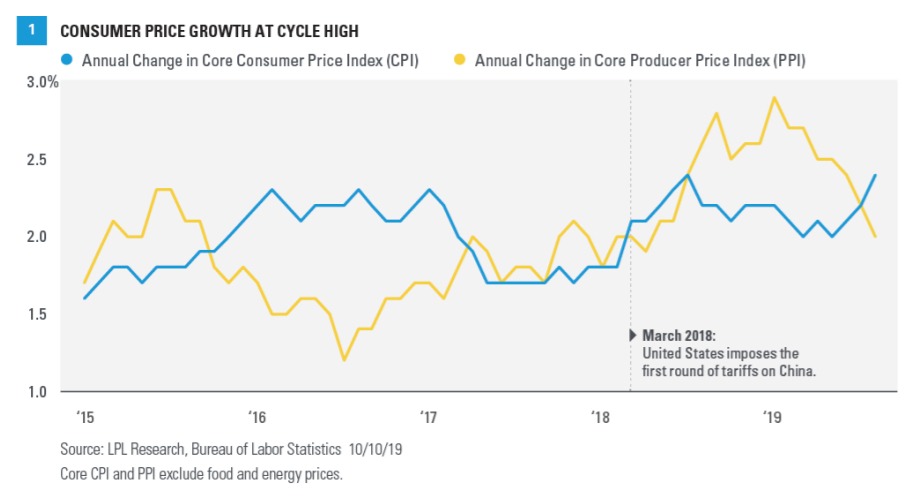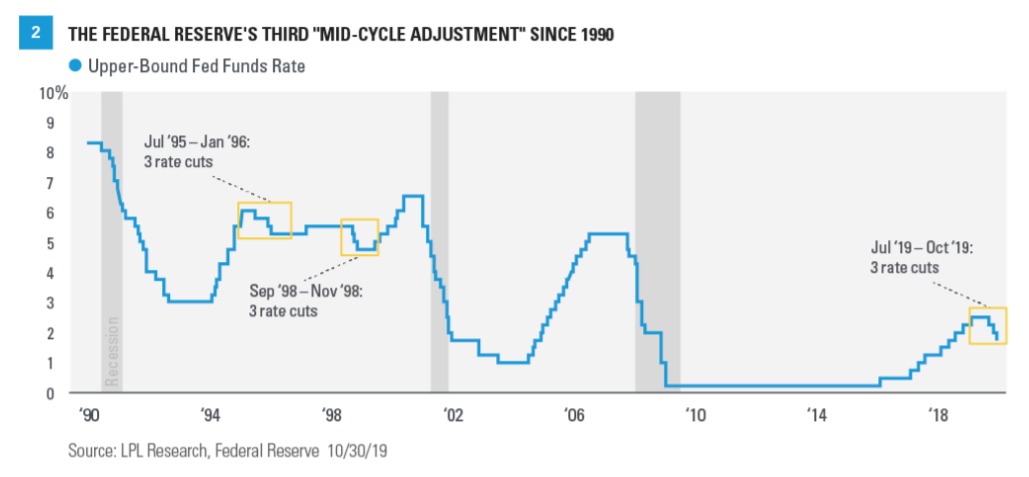ECONOMY: OCTOBER DATA SHOWS A SLOWING BUT GROWING ECONOMY
October economic data pointed to a slowing—but still growing—U.S. economy.
The Conference Board’s Leading Economic Index (LEI) rose 0.4% in September, its slowest pace of growth since 2016. However, the LEI is still growing year over year, a good sign for the future of the economic expansion.
Gross domestic product (GDP) grew 1.9% in the third quarter, its slowest pace of growth since the fourth quarter of 2018. Still, GDP increased 2% year over year last quarter, slightly below 2.1% year over-year average growth since the cycle started in July 2009. Consumer spending contributed 1.9 percentage points to the GDP increase during the quarter, while government spending added 0.4 percentage points.
Nonfarm payrolls climbed in September, according to early October data, and July and August payrolls growth was also revised upward. The 12-month average payrolls change through September was slightly higher than the expansion average.
Inflation data sent mixed signals. Wage growth slowed notably last month, hinting that inflationary pressures could be moderating. Average hourly earnings growth fell to 2.9% year over year, the slowest pace since July 2018.
However, one measure of consumer inflation grew at the fastest pace of the cycle in September. The core Consumer Price Index (CPI), which excludes food and energy prices, rose 2.4% year over year last month [Figure 1].

Core personal consumption expenditures (PCE), the Federal Reserve’s (Fed) preferred inflation gauge, increased 1.7% year over year in September. Year-over-year core PCE growth is still slightly below the Fed’s 2% growth target.
U.S. manufacturing deteriorated further, caving to a global trend of weakness in the sector. The Institute for Supply Management’s (ISM) Purchasing Managers’ Index (PMI) fell to 47.6 in September, the lowest level since June 2009. Markit’s U.S. manufacturing PMI remained just above 50, or the threshold between expansionary and contractionary territory.
Underlying data on the U.S. consumer weakened. The Conference Board’s Consumer Confidence Index slid for a third straight month in October. Retail sales declined in September after six straight months of gains.
Business spending continued to stall. Orders for nondefense capital goods, which excludes aircraft, were flat year over year in September.
The Fed Signals Rate Cut Pause
On October 30, the Fed reduced interest rates by 25 basis points (0.25%) in its third rate cut of the economic cycle. While the headline decision was dovish, the Fed signaled this could be the last rate cut for a while, which would end its third “midcycle adjustment” since 1990 [Figure 2]
The clearest hint was policymakers’ removal of language stating they would “act as appropriate to sustain the expansion.” Going forward, the Fed will now “assess the appropriate path of the target range for the federal funds rate.”
Fed Chair Jerome Powell doubled down on this notion in his post-meeting press conference. He kicked off his comments by saying that “monetary policy is in a good place” and that the current state of monetary policy is likely to remain appropriate as long as the economic outlook stays favorable. Powell didn’t drop the Fed’s commitment to flexibility, but he did note that downside risks had subsided.

Click here to download a PDF of this report.
IMPORTANT DISCLOSURES
Investing involves risks including possible loss of principal. No investment strategy or risk management technique can guarantee return or eliminate risk in all market environments.
The opinions voiced in this material are for general information only and are not intended to provide specific advice or recommendations for any individual security. To determine which investment(s) may be appropriate for you, consult your financial advisor prior to investing. The economic forecasts set forth in this material may not develop as predicted. All performance referenced is historical and is no guarantee of future results.
All information is believed to be from reliable sources; however LPL Financial makes no representation as to its completeness or accuracy.
For a list of descriptions of the indexes referenced in this publication, please visit our website at lplresearch.com/definitions.
This Research material was prepared by LPL Financial, LLC.
Securities and advisory services offered through LPL Financial (LPL), a registered investment advisor and broker-dealer (member FINRA/SIPC). Insurance products are offered through LPL or its licensed affiliates. To the extent you are receiving investment advice from a separately registered independent investment advisor, please note that LPL is not an affiliate of and makes no representation with respect to such entity.
If your advisor is located at a bank or credit union, please note that the bank/credit union is not registered as a broker-dealer or investment advisor. Registered representatives of LPL may also be employees of the bank/credit union. These products and services are being offered through LPL or its affiliates, which are separate entities from, and not affiliates of, the bank/credit union. Securities and insurance offered through LPL or its affiliates are:
Not FDIC or NCUA/NCUSIF Insured | No Bank or Credit Union Guarantee | May Lose Value | Not Guaranteed by Any Government Agency | Not a Bank/Credit Union Deposit
Tracking # 1- 915463 (Exp. 11/20)
